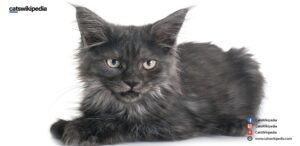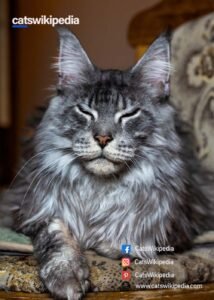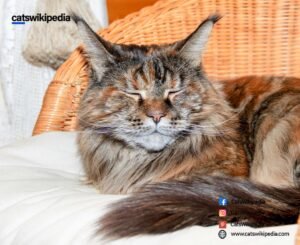GREY MAINE COON
INTRODUCTION
The Maine coons are among the giant cats in the world, with the current record holder at the moment-a Maine Coon named Ludo-which measures 45.6 inches from tip to tail. These gentle giants represent some of the best companions available in a wide array of coat colors and patterns.
One would almost say that the Gray Maine Coon cat is handsome in his handsomeness, as in his gentleness. Indeed, this is a breed exuding style and elegance, commanding with size, tufted ears, and paws. The Maine Coon represents one of the giant domesticated cat species, muscular in length and power, which it exudes without losing agility.
The color variations of the Grey Maine Coon range from silvery to charcoal in so many tones and often with a smattering of lighter undercoats displaying its natural beauty. Its wide eyes, more often gold, green, or amber, add depth to such an already engaging character with an air of allure attached to it.

In addition to their handsome looks, the Grey Maine Coon is also in high regard for the friendly and affectionate nature it possesses. These gentle giants are always alert and usually grow attached to their companions. They are intelligent and playful, love interactive toys, and are naturally inquisitive about the world around them.
They are such adaptable and social animals that they quickly get on to being excellent companions for families or other pets, fitting in without any hassle whatsoever. Grey Maine Coon, because of its exceedingly affectionate nature and attributes alone, distinguishing it due to its bodily grandeur and amiable disposition, has earned it a place as the most treasured member of so many families worldwide.
REALITY OF GREY MAINE COON
Are grey Maine Coons even a thing? To the unit casual observer, there are a number of grey Maine Coon cats in this world. Some are grey with either silver or smoky flecks, while some are even grey with white fur streaks. Some have a solid grey tint overall.
They aren’t grey, however-at least, not according to the Cat Fanciers Association and other cat groups. They are instead known as “blue.” Grey or silver cats are called blue due to the bluish tint their coats take on. It is a subtle shade-one akin to that worn by military cadets. Cats with grey-colored coats essentially have diluted black skin, genetically speaking, at least.

GENETIC COMPOSITION OF GREY MAINE COON
Cats do have genetic sequences holding up a gene, which is more popularly described as the dilute gene or melanophilin. Not all cats carry this gene, and when they do, it does not always express itself in a diluted coat.
The dilute phenotype, or more correctly, a diluted color coat, only develops in a cat with two copies of this dilute gene. It is only possible because it gets one from each parent; thus, its inheritance is autosomal recessive and not expected.
This is because of the protein called melanophilin, which influences the dispersion of melanin granules or pigment in a cat’s hair. Cats that are not carriers of the dilute gene have normal pigmentation over their coats. Cats carrying the gene in double doses do not have even coloring; instead, they have clumping of the pigment, which causes a variety of problems.
If so, why are the colors diluted and not missing? The areas or clusters of pigmented and non-pigmented are small. Since we don’t have microscopic eyesight, the colors appear mixed and diluted when our eyes look at them. That is to say, if you are looking at a blue Maine Coon, you are actually looking at a black cat that carries two copies of the dilute melanophilin gene. Other dilute colors are lilac.
How Do You Predict the Color of a Maine Coon Kitten?

Coming along with Maine Coons, there are some relaxed genetic rules whereby predicting the color of a kitten is by no means challenging. Male kittens receive both their color genes from the dam. Consequently, such reasoning will more or less lead you to conclude that boy kittens will always carry their mommy’s color or a dilute of the same shade.
The grey male kittens are born to black or blue mothers of Maine Coon. Female kittens, however, get one gene for color from each parent. So, they are most likely to depict mixed hues or unusual color combinations.
How Rare Are Blue Maine Coon?
Blue is not the regular color for Maine Coons. Their regular colors are black, cream, and white. Now as for the solid blue Maine Coons, well, they actually are not that uncommon. It’s infrequent but is not unpopular either.
There have been recorded instances of Maine Coon cats with over 85 different color combinations. With that many options available, it surely must be not easy to make a choice.
 CONCLUSION
CONCLUSION
The Grey Maine Coon cat speaks of style, intellect, and aesthetic appeal within the feline world. The imposing structure with a combination of grey-silver fur draws a great deal of attention and applause. A Maine Coon cat of this type has friendly nature and is thus more interactive due to its fascinating physical looks. Beautiful cats like these have it in their distinctive, easygoing, and friendly disposition that they continue attaching themselves to people, often boisterous and outgoing.
Their intelligence and ease of adapting make them more than pets but members of the family. With eyes speaking a thousand words and melodious purrs, they are able to express emotions and reach out, providing in their unique manner the comforts of friendship.
The Grey Maine Coon carries over into the legacy much more than just its presence, a resilient presence of grit. Their story, enveloped in a history of folklore and tales of survival, speaks volumes of their ability to live and adapt. The fact that it has remained popular over such a period says much about its timeless appeal and charismatic charm.
The Grey Maine Coon cat was an animate representative of that singular blend of poise, companionship, and strength that gets etched upon the heart of the few really fortunate persons who get to share a lifetime with such magnificent creatures. May their memory be alive and serve as witness to how such magnificent felines change our lives.





